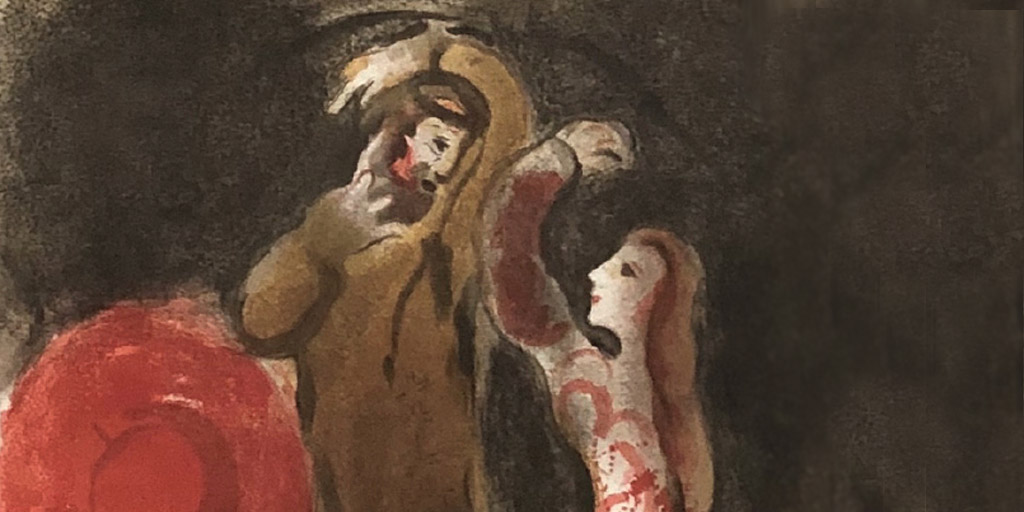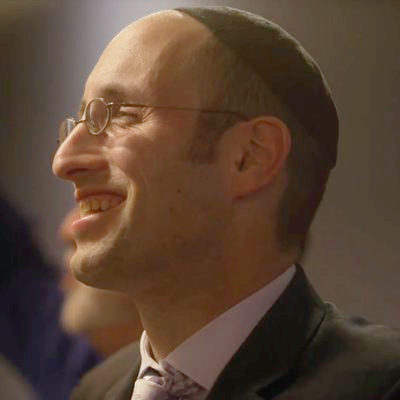Loss, Discovery, and a Lost Discovery in “Reading Ruth”
A grandfather and granddaughter learn together to mourn the wife and matriarch who is missed, and to rediscover her own wisdom in an ancient text.

On the upcoming holiday of Shavuot it’s customary to read the book of Ruth in synagogues, and it has now become routine to see the appearance of new commentaries on this text as Shavuot approaches. This year, we have Reading Ruth, which is not only beautifully written and full of intriguing interpretations, but also interestingly authored: composed by a grandfather and granddaughter. Leon Kass, one of the coauthors, is one of the most insightful scholars and teachers of our time, a longtime professor at the University of Chicago and a dean at Shalem College. Throughout his career, he would often teach together with his late, beloved wife, Amy Kass. It was in mourning for Amy that this book came to be, for in his grief Kass began to study the book of Ruth with his granddaughter Hannah Mandelbaum. As they explain, in engaging in joint study they had not intended to emerge as authors of a book on Ruth; rather, they were seeking solace.
We did not start out intending to write a book. We began, in the fall of 2015, merely seeking to give comfort to each other following the death of our beloved Amy Apfel Kass—wife of 54 years to Leon; grandmother (“Gaga”) of sixteen years to Hannah. Leon was living, then as now, in Washington, DC; Hannah was living, then as now, in Jerusalem. The idea was Hannah’s, suggested in one of her daily calls: “Zeydeh,” she said, “perhaps you would like to read something with me.” Leon grabbed the offer: a log brought to a drowning man. We settled easily and quickly on the book of Ruth. Not only was it short and lovely. It also had special meaning for Leon. Some twenty years earlier, Amy and he had made a discovery in the book of Ruth that they thought might be the key to understanding its meaning, and they had spoken about working on it in the future. But that never arrived, and Leon had forgotten the insight. He was therefore particularly keen to see whether, with Hannah’s help, it would be recovered.
Thus a grandfather and granddaughter learn together to mourn the wife and matriarch who is missed, and to rediscover her own wisdom in this ancient text.
And while there is a great deal to say about the substance of their reading of Ruth—some of which is highlighted in the review by Hillel Halkin that accompanies this reflection—I wish to explain the significance of the book having been written by these two remarkable people: it is the very endeavor in which they engaged that entranced me: grandfather and granddaughter, seeking solace for their loss, decide to study Torah together. And how fitting it is that it was Ruth that they studied.
For the solace that comes to the bereaved through connection to loved ones is Ruth’s great theme. Indeed, rightly understood, that is the meaning of the often-mistranslated word that is central to Ruth itself: ḥesed. What is ḥesed? The word is often rendered as “loving kindness,” but as Kass and Mandelbaum note, the real meaning is a bit different. Consider the famous verse from the second chapter of Jeremiah: “Thus saith the Lord, I remember the ḥesed of your youth, your bridal love, that you followed me into the desert, into an unsown land.” What ḥesed did the Jewish people then show to the Almighty, in following Him into the desert? Was it really a demonstration of kindness?
I think instead it is an expression of loving loyalty, or loyal devotion. When the Israeli prime minister Menachem Begin, upon election to the premiership, told his own beloved wife Aliza—in the words of Jeremiah—that he remembered the ḥesed of her youth, her bridal love, that she followed him into—not an unsown land, but an erets z’ruat mokshim, a land strewn with mines—he was praising her loyalty, the devotion that led her to stand by and support her husband when he was the most wanted man in Mandatory Palestine, when every day she rose knowing that she might never see him again.
Ḥesed means loving loyalty, ardent devotion, or as I would render it, loyal love. Ḥesed, say the sages, is the central theme of the book of Ruth, and indeed it is. Ruth shows Naomi ḥesed by refusing to forsake her; and Boaz, in turn, shows ḥesed to those who have died by marrying Ruth and perpetuating the family. Hence the beautiful blessing uttered by Naomi, one of the most exquisite sentences in scripture: “blessed is the Lord who has not forsaken His loyal love for the living and the dead.”
If this is so, then can there be anything more fitting than a grandfather and granddaughter studying Ruth, to show loyalty and love to one whom they had lost, and to each other? To engage in the study of Torah across the generations is, truth be told, unusual in today’s society. In his 2017 book The Vanishing American Adult, the Nebraska senator Ben Sasse notes that today’s youth very rarely seriously engage the older generation, or as he put it, among those 60 and older, “only a quarter had discussed anything important with anyone under 36 in the previous six months.” How many grandchildren sit and study a text—any text—with their grandparents today?
Thus the very existence of Reading Ruth invites us to ask that central question of who we are. Are we primarily individuals unbounded, free to define ourselves, or do we find ourselves in our obligations to others? This is one of the questions that Kass and Mandelbaum explore, and that emerges with such charm in the book of Ruth. And it does so by way of what is perhaps the strangest name in the entire Bible. I am referring, of course, to a relation of Naomi’s late husband Elimelech, the man who by rite is supposed to marry Ruth, and thereby perpetuate the family and its memories. This man refuses, not seeing, as Boaz did see, Ruth’s greatness.
This man is called Ploni Almoni, which, as the biblical equivalent of John Doe, tells us that the text wishes him to be anonymous. The Bible erases his name, or rather it goes out of its way to deny us his personal name, and the reason for this can be discovered in an article that Leon and Amy Kass together wrote about the meaning of naming and the names we all carry. In “What’s your Name,” recently republished in Leon Kass’s Leading a Worthy Life, they argue that naming is an example of how parents form children, choosing on their behalf, and of how a child, in turn, encounters his own identity as a product of someone else’s decision.
Parents take the responsibility very seriously; or perhaps most do. The Kasses amusingly describe a Jewish family from Shaker Heights, who some decades ago decided to name their child Lancelot, and then, when they would call him in to the house, would endow the appellation with a Yiddish diminutive, and so their voices would ring throughout the neighborhood: Lancelotkele! Lancelotkele! But in general parents sense the responsibility in the choice, and often in naming the child after someone from the family or the Bible or a distinguished personage from history, they seek to impress a legacy and ideal upon the child. Leon and Amy Kass put it this way:
In all these ways, the naming of a child is, in fact, an emblem of the entire parent-child relation, in both its human generality and its radical particularity. Human children are born naked and nameless, like the animals; they become humanized only through rearing, the work not of nature but of acts of speech and symbolic deed, including praise and blame, reward and punishment, custom, habituation, and education. They become humanized, in the first instance, at the hands of parents, who, among other duties, try steadily to teach children how to call all things by their proper names and to show them how to acquire a good name for themselves.
The paradox of the name is that while it seems to mark us as an individual, that individual meaning is a product of our parents, and thereby it reminds us that we are not simply individuals, but recipients and stewards of a larger whole. If Someone-or-Other, Ruth’s Ploni Almoni, desists from his familial obligation to past and posterity, then his individual qualities recede into anonymity.
In Reading Ruth,grandfather and granddaughter learn this lesson well, and as they make their way through the text of the book of Ruth, they remember Amy Kass, their wife and grandmother, and rediscover her insights. In so doing, they bind themselves to each other, and link past and future. The book itself is one of the most interesting examples of the talmudic dictum that when one bids goodbye, one should do so with words of Torah, “for through this, you will remember your comrade.” The words of sacred scripture bind us to one another, connecting us across space and time. Here, they came to be in bidding farewell to one they have lost, but in the act of study and composition, our coauthors find her again, remembered, renewed.
At the end of the book, Kass writes that his “loss of Amy has been partly redeemed also by Hannah’s Ruth-like and Amy-like ḥesed—her gracious kindness and loving devotion—which she has steadily showered on me and on Amy’s memory. I am overwhelmed with gratitude for these blessings.” Reading Ruth is, in other words, Kass’s own way of expressing what Naomi said thousands of years ago, blessed is God who has not removed His own loyalty from the living and those no longer with us.
This essay was originally published in Mosaic.
Rediscovering the wisdom of the departed in an ancient text.
Rediscovering the wisdom of the departed in an ancient text.

